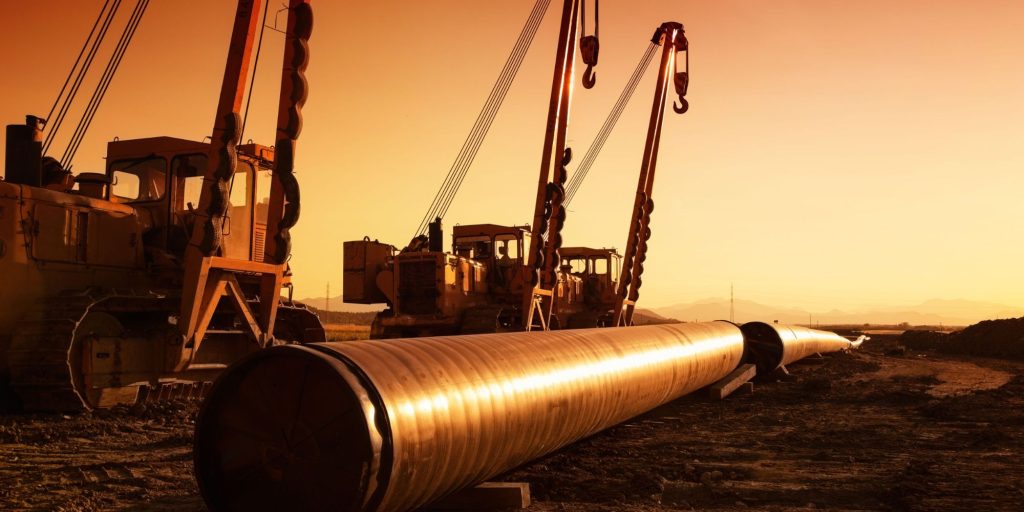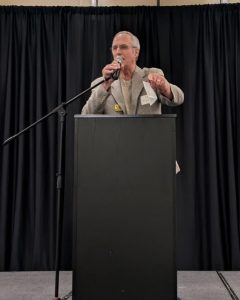This article was originally published in the Western Organizing Review.
Dakota Rural Action’s work against carbon pipelines shows how people power can beat big moneyed interests.
By Eric Warren
In 2021, farmer and longtime Dakota Rural Action (DRA) member Ed Fischbach received a letter from Summit Carbon Solutions, a company he’d never heard of. The letter included detailed maps of his property showing where the company planned to build a carbon dioxide pipeline.
“I was shocked,” Fischbach said. “It was going to cut diagonally right through my whole farm operation, right through my home quarter, and right across the road from me. It was going to just devastate my livestock operation.” Even more alarming than seeing the maps was the fact that the letter laid out the company’s threat of eminent domain, the practice of forcing landowners to give up their property for projects deemed to be “in the public’s interest.”
One of Fischbach’s early calls was to Frank James, DRA’s then director, who assured Fischbach that DRA was on board to help his community organize around this new threat.
“It was like Summit just took gasoline, doused the crowd, and threw a match. That may well be the moment that ignited the movement in South Dakota.”
-Chase Jensen, DRA lead organizer
Fischbach was no stranger to organizing. As a teenager, he’d organized against the flooding of South Dakota lands by the Oahe Water Project. Decades later, he attended one of Summit’s early public meetings. The meeting hall was packed with concerned farmers and other landowners. Once Summit’s representatives finished their presentation, Fischbach stepped up to the microphone and asked the question that had most likely been on everyone’s mind: will Summit rule out using eminent domain for its project? After some waffling, the Summit representatives said no.
“It was like Summit just took gasoline, doused the crowd, and threw a match,” said DRA lead organizer Chase Jensen. “That may well be the moment that ignited the movement in South Dakota.”
Over the next few years, people from across the political spectrum and a diversity of backgrounds came together to defeat the pipeline at every level of state government, from county commissions to the governor.
Carbon pipelines – a new kind of threat
The Summit Carbon Solutions pipeline project is part of an expanding push for carbon capture, utilisation, and sequestration (CCUS) infrastructure happening around the country. In this case, carbon dioxide, generated by the processing of ethanol throughout the northern Great Plains, is captured and transported at extremely high pressure through pipelines to North Dakota for permanent sequestration about a mile underground.
Opponents of the project have always been convinced that the true end goal is to bring the CO2 to North Dakota’s oil fields for what’s called “enhanced oil recovery,” forcing hard-to-extract oil from fracked shale to the surface. Using CO2 for enhanced oil recovery ensures that more carbon will be released into the atmosphere through both continued oil production and possible leakage from the wells once the oil is gone. It’s a lose-lose for the climate.
It’s also a losing situation for the people whose property the pipelines would cross. Impacted landowners notified about the Summit project had immediate concerns about itt, which only increased as they learned more about it. There have been over 8,000 major spills from oil and gas pipelines since 1986, with 578 in 2020 alone. When a CO2 pipeline ruptures, it can expel an enormous plume of colorless and odorless gas because of the high pressures carbon dioxide is transported under. Due to its heavier-than-oxygen nature, CO2 replaces the oxygen at ground level creating a massive “dead zone.” In 2020, a CO2 pipeline near Satartia, Mississippi ruptured.
As NPR reported at the time, “More than 200 people evacuated and at least 45 people were hospitalized. Cars stopped working, hobbling emergency response. People lay on the ground, shaking and unable to breathe. First responders didn’t know what was going on.” Luckily, everyone escaped with their lives, but many residents are still dealing with resulting impacts on their health.
While the safety issues concerned South Dakota residents, it was Summit’s contempt for property owners that infuriated residents. “Their whole attitude was that we’re going to come through here, whether you guys like it or not,” recalled Fischbach. “And you better cooperate or else we’ll break you or we’ll take you to court and sue you.” Under South Dakota’s lax state law, the company also had a pathway to use eminent domain to build their project, forcing landowners to give up their livelihoods and safety for a corporate project with little or no public benefit.
Grassroots vs. moneyed interests
When that first meeting with Summit wrapped up, people Fischbach had never met introduced themselves. They gave him their phone numbers and said, “We need to stop this. We need to organize.” Soon, Fischbach pulled together a meeting in his hometown of Mellette.
“I had over 70 people show up, which is a large crowd for my little community,” Fischbach said. “Everybody was upset. I knew then that this was an issue that was going to resonate, and people were not going to stand for it. That’s how our opposition started. That’s as grassroots as you can get.”
Even as the opposition to the pipelines grew, DRA organizer Chase Jensen knew the battle against a billion-dollar corporation and its pro-industry supporters in South Dakota’s government was going to be an up-hill one. Early on, the top priority was convincing local counties to pass zoning ordinances so that the projects couldn’t be built right next to towns, homes, schools, or other gathering places. Through DRA’s organizing, concerned residents showed up at those county commission meetings in large numbers. Summit also tried to influence commissioners, often with threats of lawsuits and other intimidation tactics.
Keep up to date with grassroots organizing in the West with WORC’s newsletter.
“When the high-powered lobbyists and lawyers of the billion dollar company show up to your county commission threatening litigation if they even consider ordinances, it sends a message,” Jensen said. “And then when the commissioners decide to do it anyway, because they’ve heard from enough members of the community, that’s real. That’s serious grassroots power.”
Key counties began passing zoning ordinances against the will of the company and top political operatives in the state. Within a year, McPherson, Brown, and Spink Counties defied Summit’s intimidation and put ordinances in place, essentially blocking the pipeline’s route north out of South Dakota. “It would have been very easy to crumble and be intimidated and scared,” Fischbach said, recalling one of the commission meetings he attended. “Every one of those commissioners, they withstood the lawsuit, they withstood the threats, they held firm, and that’s what did it.”
DRA and allies built on that momentum, and over the next few years, the campaign to stop carbon pipelines across South Dakota had some extraordinary wins. Over half a dozen counties passed zoning ordinances for CO2 pipelines. The state Public Utilities Commission denied two separate CO2 pipeline companies’ permit applications in 2023. When an unfriendly legislature passed a law to overrule those local ordinances, the citizens of the state gathered over 32,000 signatures in 90 days to refer the law to the ballot box, where 65 of 66 counties voted it down.
“I’ve lost track of how many times people told me, when I first started organizing, that we sympathize with you, but you can’t beat these people,” Fischbach said. “They’re too powerful. There’s too much money. You just can’t win. Thankfully, we didn’t listen to that. You can defeat money if you get the people on your side.”
-Ed Fischbach, South Dakota farmer and DRA leader
With help from Brian Jorde, a lawyer who defended farmers and ranchers from TC Energy’s attempts to seize land for the Keystone XL pipeline, the impacted landowners formed a legal cooperative and took the battle beyond the permit hearings and into the courts, winning a key decision in the South Dakota Supreme Court. After the 2024 elections brought significant changes to the makeup of the legislature—due to the strength of this issue in rural South Dakota—the 2025 legislature passed a bill banning eminent domain for CO2 pipelines. Governor Larry Rhoden signed the bill into law in March.
Summit Carbon Solutions was soon dealt another blow when the Public Utilities Commission threw out their second permit application due to their inability to acquire voluntary easements from vast stretches of their proposed route.
“I’ve lost track of how many times people told me, when I first started organizing, that we sympathize with you, but you can’t beat these people,” Fischbach said. “They’re too powerful. There’s too much money. You just can’t win. Thankfully, we didn’t listen to that. You can defeat money if you get the people on your side.”
For Jensen, DRA’s organizing philosophy played a key role in winning at all levels.
“The reason I think we were successful in what we did was our belief that there are leaders out there, regular people who can be brought into public life and who can advocate on their own behalf,” Jensen said. “That’s really at the center of community organizing. It’s not to go organize existing parties, existing donors, existing activists. It’s to find new people that aren’t part of it and bring them to the table.”
Deep roots in community
Jensen believes DRA’s deep ties to South Dakota communities allowed the organization to respond quickly when Fischbach received that first letter. DRA has almost 40 years of experience in South Dakota, and a reputation of fearlessly taking on controversial issues and helping people stand up for themselves and their communities against powerful corporations.
“Every single fight has been like David versus Goliath,” Jensen said. “To have victories like this in the midst of some of the deepest unsettling moments in our national political scene, what a time to deeply learn the lesson of how powerful community organizing can be.”
“Every single fight has been like David versus Goliath. To have victories like this in the midst of some of the deepest unsettling moments in our national political scene, what a time to deeply learn the lesson of how powerful community organizing can be.”
-Chase Jensen, DRA lead organizer
While DRA and members like Fischbach have rallied people to big wins against CO2 pipelines in South Dakota, the fight is far from over. Lawmakers in Washington D.C. are testing the waters on legislation that would allow the federal government to preempt state and local pipeline permitting. Such a provision was included in an early draft of the 2025 budget reconciliation bill, but was removed before the House passed the bill.
Recent people-powered wins against long odds give Fischbach hope that the same principles will win at the national level as well.
“That’s the lesson I’ve tried to instill in people,” Fischbach said. “Don’t get discouraged by all these little setbacks. Keep fighting. Believe in what you’re doing, take a position, fight for what you’ve got, and you can prevail. Sometimes the little guy wins.”
Learn more:
From Wildlife to Wells: How Dr. Barbara Vasquez Fights for Stronger Oil and Gas Regulations
South Dakota Voters Reject Referred Law 21, Upholding Local Control and Landowner Rights

Yes, I want to help WORC elevate Western voices and hold decision-makers accountable!






